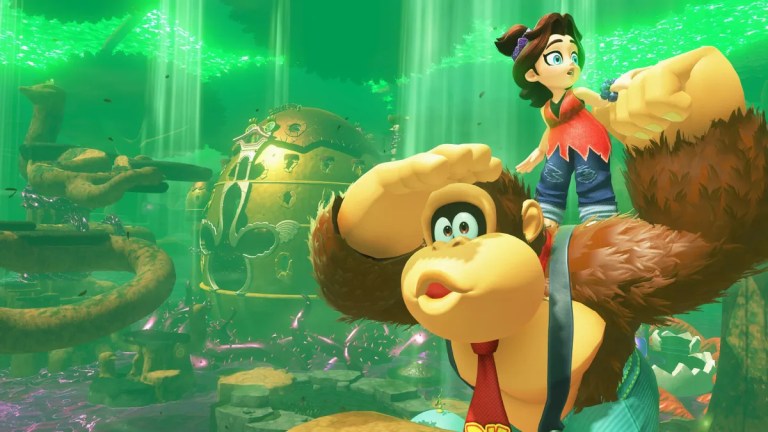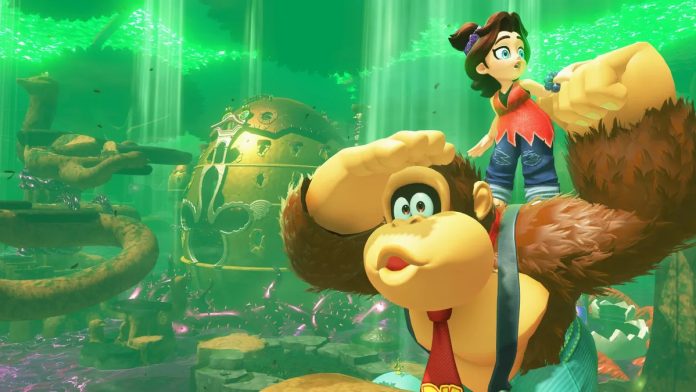 By Sam Stone | |
By Sam Stone | |

Nintendo’s breakout title was not Mario Bros. or The Legend of Zelda, but rather Donkey Kong, with the eponymous ape headlining the company’s 1981 arcade game that helped Nintendo establish a prominent foothold in the American gaming industry. Since then Donkey Kong has become a fixture for the company, either as a supporting character for Mario-led ensemble games or his own line of starring titles across Nintendo’s many home and handheld consoles. This has continued into the company’s fledgling Nintendo Switch 2 era, with the console’s Donkey Kong Bananza the most positively buzzed-about title from the Switch 2’s launch library.
Donkey Kong has a longstanding history within the video game industry, though the number of games that he primarily stars in aren’t quite as prolific as some of his other Nintendo counterparts. With that said, Donkey Kong has starred in at least one game on virtually every major Nintendo system and remains a cornerstone property for the company. Here are the top 10 best Donkey Kong games ranked, not counting his supporting character ensemble appearances.
10. Donkey Kong 64 (1999)
We’re starting off this list with a relatively divisive entry, as many have not inaccurately derided 1999’s Donkey Kong 64 as an overstuffed collect-a-thon on the Nintendo 64. To this common criticism’s credit, the game does have you replay many of the same levels with different characters—something 2004’s Super Mario 64 DS also did without as much backlash—but that overlooks the point. Indeed, not only catapulting Donkey Kong and his friends into the world of 3D platforming, Donkey Kong 64 rose above its contemporaries in the genre.
There is an under-appreciated depth to Donkey Kong 64, particularly in its rich level design and atmospheric musical score composed by Grant Kirkhope. What a lot of retrospective reviews also don’t take into account is that there was a ton of 3D platforming slop flooding the market after the success of Super Mario 64 and Banjo-Kazooie, slop that Donkey Kong 64 clearly stood a cut above during its release. Certainly not without its flaws, Donkey Kong 64 deserves far more love than it gets these days, or at least a less dubious reputation.
9. Donkey Kong Jungle Beat (2004)
Nintendo home consoles have a longstanding legacy of quirky peripherals, a tradition that was continued by the Nintendo GameCube at the dawn of the 21st century. After introducing the DK Bongos, a bongo drum peripheral for the GameCube and 2003’s Donkey Konga, the peripheral was given more optimized gameplay experience in 2004’s Donkey Kong Jungle Beat. The game continues the rhythm-based gameplay from Donkey Konga, albeit within a side-scrolling platformer controlled by the drums.
One of the most accessible Donkey Kong games in terms of difficulty, Jungle Beat takes the DK Bongos to their logical apex in usage. More than just providing a unique mechanic in moving across the levels, there is something fundamentally cathartic about pounding on a set of bongos to pummel an imposing boss. A forgotten entry in the Donkey Kong franchise because of its signature peripheral, Donkey Kong Jungle Beat should receive an update given the possibilities through Nintendo’s continued motion control support.
8. Mario vs. Donkey Kong (2004)
While Mario and Donkey Kong may be nominal buddies now, palling around throughout various Nintendo sports titles, Mario Kart, and Mario Party, there was a time when they were bitter rivals. That antagonistic history is revisited in 2004’s Mario vs. Donkey Kong for the Game Boy Advance, the spiritual successor to 1994’s Donkey Kong on the original Game Boy. The game’s offbeat story has Mario own and run his own toy factory, which is raided by Donkey Kong for the factory’s popular line of wind-up Mini-Mario figures.
Mario vs. Donkey Kong ups the ante from the puzzle-solving gameplay and traversal present in the 1994 Game Boy game, adding a new wrinkle with the presence of the Mini-Marios which have to be navigated to safety. The game received a surprise remake on the Nintendo Switch in 2024, making the controls more intuitive to the modern console while significantly upping the technical presentation. While we’re certainly happy that Mario and Donkey Kong play nice again these days, Mario vs. Donkey Kong is a fresh take on one of gaming’s oldest beefs.
7. Donkey Kong Country Returns (2010)
After completely revitalizing the Metroid franchise, developer Retro Studios did the same for Donkey Kong with 2010’s Donkey Kong Country Returns for the Wii. Returning to the side-scrolling platforming that made Rare’s original Donkey Kong Country trilogy such a major success on the Super Nintendo, the game has Donkey and Diddy Kong take on a new villain, the Tiki Tak Tribe. In a change-up from previous titles in the series, the game also allows for two-player simultaneous co-op, with the second player controlling Diddy.
Donkey Kong Country Returns is a welcome, hurm, return to form for the franchise, although not without a few bumps in its execution. Boasting a faster pace than the original trilogy, the Wii revival is markedly more difficult than many games in the series, something that highlights how frustrating the console’s motion controls can be. The game received slightly enhanced remasters on the Nintendo 3DS and Switch, upgrading the visual presentation, though its gameplay flaws are still present and these remasters don’t add all that much to the overall experience.
6. Donkey Kong Country 3: Dixie Kong’s Double Trouble! (1996)
At the twilight of the Super Nintendo’s lifecycle, and after the Nintendo 64 had already launched, Rare released one final Donkey Kong Country game for the SNES: 1996’s Donkey Kong Country 3: Dixie Kong’s Double Trouble! Just as Donkey Kong Country 2 ditched Donkey Kong himself, its sequel also discards Diddy, replacing him with the new playable character Kiddy Kong. Together, Dixie and Kiddy set out to rescue Donkey and Diddy from Baron K. Rool in a northern region with its geography inspired by Scandinavia and Canada.
Though Donkey Kong Country 3 may be the weakest entry of the original trilogy, it is by no means a bad game and brings some fresh changes to the series, specifically, an open hub map and vehicles. But the game just doesn’t quite feel as inspired as its two predecessors, even with the protagonist swap to introduce Kiddy. A solid if seemingly obligatory coda to the original Donkey Kong Country trilogy, Donkey Kong Country 3 retains the core appeal as it goes through well-worn territory.
5. Donkey Kong Country: Tropical Freeze (2014)
Relegated to being a supporting character for years, Cranky Kong makes his playable debut with 2014’s Donkey Kong Country: Tropical Freeze for the Wii U, joined by a returning Dixie. The game has Donkey Kong’s birthday party interrupted by the attacking Snowmads, an army of arctic animals plotting to conquer Donkey Kong Island and plunge it into endless winter. The Kongs battle their way back to the heart of their native island, defeat the Snowmads and defrost their home from its newly icy condition.
Tropical Freeze is an all-around improvement over Donkey Kong Country Returns, significantly refining the gameplay mechanics and level design. At the same time, the difficulty remains as high as ever while the overall number of levels is reduced from its predecessor. A solid addition to the series, the definitive Tropical Freeze experience is its enhanced remaster on the Nintendo Switch, adding Funky Kong as a playable character.
4. Donkey Kong Country (1994)
To anyone who was around and playing video games in 1994, the original Donkey Kong Country was a huge deal when it debuted on the Super Nintendo that year. With its crisp, pre-rendered graphics, there was nothing else that looked that good on the console market at the time, helping steer the industry towards more 3D aesthetics. The game’s story is simple: King K. Rool raids Donkey Kong Island and steals Donkey Kong’s vast stash of bananas, prompting the ape and his nephew Diddy, in his first appearance, to recover their purloined fruit.
If it was just about that initial wow factor from its pre-rendered presentation, we wouldn’t still be talking about Donkey Kong Country over 30 years after its launch. But more than just its eye-catching visuals, the game completely redefined Donkey Kong down to his character design and reestablished him as a core Nintendo property. That legacy stems from a combination of impressive technical presentation, an instant-classic score composed primarily by Grant Kirkhope, and an engaging side-scrolling platformer experience that this first game all brings to the table.
3. Donkey Kong (1994)
Initially 1994’s Donkey Kong on the Game Boy looks and feels like a smoother, more intuitive port of the classic 1981 arcade game of the same name. However, after completing the four levels from the arcade title, the 1994 game expands into a full-on adventure as Donkey Kong kidnaps Mario’s girlfriend Pauline again and hightails it across 97 additional levels in nine-themed worlds. Joining Donkey Kong in trying to stay one step ahead of Mario is Donkey Kong Jr. while the mustached plumber gains a new set of moves to keep up with the apes.
The Game Boy Donkey Kong is a love letter to both the original arcade and its 1982 sequel Donkey Kong Jr. while ambitiously building upon these foundations. At its core, the game is more of a puzzle-solving experience than a platforming one, with that distinction more evident in the level design as players progress. That helps elevate 1994’s Donkey Kong tremendously from similar games in the franchise and a refreshing twist on a familiar premise.
2. Donkey Kong Country 2: Diddy’s Kong Quest (1995)
If Donkey Kong Country revolutionized the way we looked at side-scrolling platformers, its 1995 sequel Donkey Kong Country 2: Diddy’s Kong Quest used that as a springboard to make the ultimate side-scrolling Donkey Kong experience. As the title suggests, Diddy steps up as the protagonist, teaming up with his newly introduced girlfriend Dixie Kong to rescue Donkey from Kaptain K. Rool. The duo travel to the pirate warlord’s hideout on Crocodile Isle where they each use their unique abilities to traverse 52 levels and rescue Diddy’s uncle.
Donkey Kong Country 2 is one of those cases where bigger does actually mean better, with more secrets, more animal buddies to temporarily control, and more enemy types to take down. The level design is more ambitious and just how differently Diddy and Dixie each play make for a much deeper and richer experience than its predecessor. An all-around improvement over the original Donkey Kong Country, the sequel stands as the apex of side-scrollers and one of the best games that developer Rare ever made.
1. Donkey Kong Bananza (2025)
Released a full month after the Nintendo Switch 2’s launch, Donkey Kong Bananza became the most buzzed-about game from the console’s library, even over Mario Kart World. This praise is well-earned, with Donkey Kong Bananza successfully catapulting its heroic ape into a full-on 3D platformer experience built around the character’s notable strength by placing him in destructible environments. The game has Donkey Kong travel to Ingot Isle to harvest Banandium Gems, teaming up with a teenage Pauline against the sinister VoidCo mining company eager to obtain the Banandium Root, no matter the cost to the environment.
From its immersive level design, side-scrolling detours straight out of the original Donkey Kong Country in a fun and emotional tribute, and a redesigned Donkey Kong character design with plenty of personality, Donkey Kong Bananza repositions DKas a marquee Nintendo franchise. But for all its celebration of the entire history of all things Donkey Kong, Bananza is just a lot of fun, with its key gameplay mechanic of literally tearing through environments being incredibly cathartic. This game lets players go nuts and bash and smash everything around them. A subtle reinvention of what’s possible for a Donkey Kong game, Donkey Kong Bananza is Nintendo’s best 3D platformer since at least 2017’s Super Mario Odyssey, and the most unabashedly fun Donkey Kong game in, well, ever.
